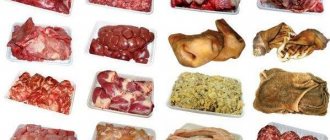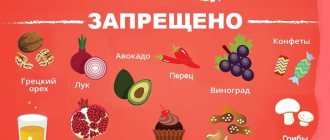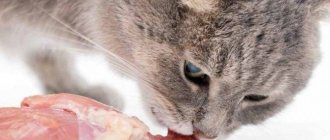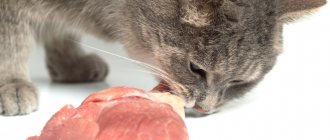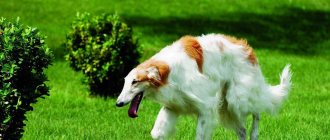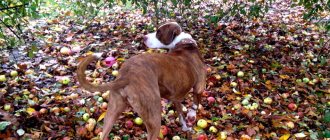What to choose
Any meat you choose for your dog should not contain fatty layers. But there may well be veins, cartilage, etc. in it.
Beef
One of the most common types of meat used in feeding dogs. Beef is not allergenic, unlike chicken, and does not contain too much fat, unlike pork. Suitable for almost all breeds. Optimal in terms of benefit/price ratio. Contains a lot of iron, which is responsible for hematopoiesis.
Beef is preferable to dogs for dogs because it has better vitamin and amino acid composition.
Mutton
Suitable for most breeds, non-allergenic. Contains many B vitamins, beneficial for coat and muscles. It is advisable to choose young lamb.
horsemeat
Easier to digest meat than beef, not fatty, non-allergenic. However, it is not suitable for daily feeding. Some dogs don't like the taste.
Venison
The best meat for pets, less fatty than beef and horse meat, highly digestible, nutritious, very healthy. The only drawback of venison is its high price. In addition, such meat can be difficult to find in the store.
Pork
Controversial meat for many breeds. Pork has a high fat content, which makes it less digestible than other types. Such meat can lead to indigestion and pancreatitis. Pork is contraindicated for some breeds (small, decorative, with sensitive digestion) and dogs prone to obesity. Pork is prohibited for puppies under three months of age.
Lean pork (shoulder, tenderloin) can be given in winter to dogs living in outdoor enclosures, chain dogs, and large energetic pets. It is preferable to boil it, since raw pork may contain worm eggs.
Rabbit meat
Dietary, but not suitable for all dogs. For the first time, give the animal a small piece and monitor its condition. You can continue to feed rabbit meat only if there are no signs of allergy.
What to give meat to dogs
No matter how useful a product meat is, it is not able to fully provide the dog’s body with everything it needs. Food should be varied . The remaining half of the diet should include cereals (25-35%), dairy products (20-30%), vegetables (10-15%).
Dairy products should always be a separate meal and should not be mixed with anything else. This can be cottage cheese, kefir, yogurt, natural yogurt without sugar or additives. It is not recommended to give milk to adult dogs due to poor lactose tolerance. In an animal, drinking milk can cause bloating and diarrhea.
The ideal cereals are rolled oats, rice, buckwheat, barley and wheat groats . Meat products are given either together with porridge or with a small addition of chopped vegetables (cabbage, tomatoes, carrots). You can combine all three types of components. Legumes are contraindicated for animals.
By-products
You can add offal to your dog's diet - kidneys, liver, heart, stomachs, etc., but they should not completely replace meat. By-products are given in boiled form. Their nutritional value is lower than that of raw lean meat. You can give it once or twice a week.
Beef tripe can be fed raw to your dog. Tripe is very useful, it contains phosphorus, zinc, iron, cellulose, and improves digestion.
Chicken bones, heads, and necks should not be given, as this will lead to constipation.
What are the contraindications?
But it’s worth figuring out whether a dog can eat raw meat, since this product can only be given to a healthy animal.
- If your pet has problems with the digestive system and does not digest this food well, you need to reconsider its diet. You can pay attention to the quadruped's stool. If after eating the product it is not the same as usual, the animal may have problems digesting it. Even poor digestibility is possible, in addition, there may be an allergy to this product. In this case, you need to contact a veterinarian.
- If your dog has liver and kidney problems, giving it chicken is dangerous. It contains many purines, which promote the secretion of uric acid.
- If you decide to feed your pet a new type of meat, introduce it into the diet gradually and monitor the body’s reaction.
In what form to give
It is best to feed your dog raw meat; it is much healthier for the animal. The digestive system of canines is adapted by nature specifically for digesting raw meat. At the same time, special digestive enzymes in gastric juice neutralize most pathogenic bacteria.
An alternative to raw meat is boiled meat.
More boiled meat is required, but it is digested worse and brings much less benefit. It is recommended to boil meat only if there is doubt about its quality.
It is forbidden to give fried or smoked meat to dogs.
Raw meat is given in large pieces so that the dog has to tear them with his teeth and chew them. This promotes natural teeth cleaning. The exception is small breeds of dogs. It is better to give them small pieces.
Bones are only given raw. Boiled bone can cause constipation.
Recommendations and standards for feeding dogs meat
Monge: dog food for small and large breeds
The packs of dry food indicate the dog's daily feeding requirements. Manufacturers claim that the dog will receive all the necessary nutrients. It is more difficult to regulate portions if the owner decides to switch to meat food for dogs.
You should know! Meat should not be given in large pieces. It will not be digested in the dog's stomach and can damage the intestines.
The dog needs to be accustomed to the feeding regime; if the pet has not eaten a portion, the bowl is removed until the next feeding. The animal is fed after walking; the food is digested for about 7 hours while the dog is resting. It is not recommended to subject a well-fed animal to physical training.
Overeating can be distinguished by two signs:
- the dog refuses food, which means that the intestines cannot cope with the amount of food eaten, you need to give the pet a fasting day;
- The dog's stool is liquid, dark brown in color - the food contains a lot of fat, you should reduce the amount of meat, put the dog on thin porridge with meat sauce, preferably rice.
Mixture of raw meat in dog servings
Dog feeding standards
To keep the animal in shape, it is fed 2 times a day - morning and evening, puppies up to 2 months eat 6 times a day, six-month-olds - 4 times a day. A bowl of fresh water should be available to your pet at all times.
The daily feeding rate for a puppy is 7% of its body weight. Adults are given 3.5% of the dog's weight. You need to know that meat products take up 50% of the daily portion; the rest of the diet should consist of cottage cheese, eggs, and vegetables.
When feeding your pet raw meat, you need to add vitamin supplements to the food, which are sold in abundance in pet stores. Sources of fiber and minerals are cereals, vegetables, and unsweetened fruits. If the dog eats vegetables and fruits, they are given whole. Otherwise, boil the meat, grind it in a meat grinder or blender, stir it with porridge and add grated vegetables.
It is advisable to make the evening meal lighter; give your pet low-fat cottage cheese, kefir, and eggs.
Healthy treats
During walks or as one of the meals, you can give your dog dry treats made from natural ingredients. They can be bought at a pet store or ordered online.
Recently, many companies have appeared that sell high-quality meat and offal for dogs, dry meatballs, sticks, bones and chews made from natural ingredients. Brands such as Grizgo, Mnyams and Firehund purchase meat products from certified suppliers; all products have sanitary documents.
Important! When purchasing meat, you should make sure that the seller has quality certificates for the products.
Gruzgo has its own production line of dried treats and balanced sets of meat products.
"Mnyams" supplies canned food for dogs with beef, lamb, rabbit, and lamb. It is convenient to feed high-quality canned food. They contain not only assorted natural meats, but also vegetables, grains, vitamins and minerals.
Dry dog treats
How to process
Boiled pork and chicken are given to dogs. The meat is cut into pieces, dipped in boiling water and boiled for about 20 minutes.
You can dry the meat in the oven for about six hours at 120 degrees to get solid pieces. But such a treat should be given only occasionally; it is digested much worse than raw meat.
To keep your pet as safe as possible, some dog breeders recommend freezing meat. Cut the meat into pieces, place in a plastic bag and leave in the freezer until completely frozen. Thaw in portions (that is, take out a portion only for the day each time).
Cook it or give it raw?
Experts say that raw meat is healthier for dogs than cooked meat. Ideally, it should be fresh, fresh meat. But for those who do not have their own yard, this option is not suitable. Without knowing the origin of a piece of carcass or the growing conditions, it is better not to risk the dog’s health and freeze the meat in the freezer, cutting it into portions for convenience.
Those whose animals have delicate digestion boil the meat for food. In this case, it becomes easier to digest and, in addition, heat treatment destroys bacteria that cause infections and poisoning. Some dog breeders have a theory that eating a raw product causes increased aggression in a dog, so they offer it as food after cooking.
Each owner decides for himself whether to cook meat for the dog or feed it raw. It is important that the product is of high quality and has the appropriate certificates confirming this.
Daily ration
Meat should account for an average of 30-40% of the total food that the animal eats daily. When calculating the required amount, you should take into account the breed, gender, weight, temperament and lifestyle of the pet.
So, if a dog lives in an apartment and doesn’t run around much, 10-20 grams of meat per day per kilogram of weight may be enough for him. An active, energetic, athletic young dog or working animal (hunter, rescuer, etc.) needs more - up to 30 grams of meat per day per kilogram of its weight.
The norms for growing puppies have been increased, because they need a lot of microelements to form all body systems. In addition, at the age of about a year, most dogs are especially active and mobile, which means they need a complete protein diet.
The table below shows approximate values for pets of different breeds (in kilograms per day).
| Breeds | Puppy 6-12 months | Adult dog | Older dog (over 8 years old) |
| Small (an adult dog weighs less than 10 kg) | 0,5-1 | 0,4-0,8 | 0,3-0,8 |
| Medium (an adult dog weighs 10-25 kg) | 1-2 | 0,8-1,5 | 0,6-1 |
| Large (an adult animal weighs more than 25 kg) | 1,5-2,5 | 1-2 | 0,8-1,5 |
You can use the following formula for calculations: X * 2/100, where X is the weight of the dog. For example, if a dog weighs 30 kg, multiply this number by two, divide by one hundred and get 0.6 kg of meat per day.
The norm should be increased for a very active dog, for a weakened dog (for example, after an illness) or when fighting obesity (the number of fats and carbohydrates decreases, the percentage of proteins - meat increases). Then the formula will look like this: X*3/100. For example, if the dog weighs the same 30 kg, multiply by three, divide by one hundred and get 0.9 kg per day.
Raw meat: is it possible or necessary?
The risk of raw meat comes down mainly to the risk of infection with viruses and helminths that are present in animal products that have not undergone heat treatment. On the other hand, the lack of raw meat will deprive the dog of those nutrients that the cooking process kills. Raw meat needs to be frozen to kill harmful microorganisms and bacteria. Poultry can be given only boiled; raw pork is also best avoided.
Without heat treatment, dogs are given only beef, lamb, and game.
The video covers in detail the issue of raw meat products in an animal’s diet.
For adult dogs
Adult dogs can be fed raw meat, but uncooked food should be treated with caution. You should not give your animal raw poultry and pork - they contain a large number of potentially harmful microorganisms. The risk of helminth infection cannot be excluded.
It is also worth choosing only trusted sellers when feeding raw. It is safer to purchase meat products only in supermarkets - they must carry out quality control of the products; such measures are not carried out on the market. Even an adult animal should not be completely switched to a raw food diet.
Enrich your diet with by-products, which are served only in heat-treated form - they accumulate animal waste products and are of no use to your pet. Combine raw and cooked meats, be sure to add grains to cleanse the intestines with fiber and remove residues from the digestive process.
For puppies
It is better not to give raw meat to puppies at all. They are introduced to meat as such only from three months, but they start with boiled beef or game. Raw meat can harm the puppy’s digestive system, which has not yet fully developed.
If you want to accustom your baby to raw meat in the future, then first you should give frozen foods, and only then completely raw meat. Puppies need to be given more meat, up to 30 g per kilogram of weight - you can give both raw frozen meat and cooked meat together. At the end of the period of intensive growth, the need for meat products drops by half.
The basis of the puppy’s meat menu is beef, game, and lean parts of turkey. By-products are introduced carefully - only after heat treatment!
Sorry, there are no surveys available at this time.
Veterinary and Animal Science
Dogs are carnivores, so about half of a dog's diet should be meat.
Today, choosing meat for dogs is not difficult; just go to any butcher shop and you will most likely see trimmings and liver there that you can buy for your pet. Often the price of such meat is no more than 100 rubles. Many owners prefer to give chicken instead of cheap meat, rightly considering it not safe for the dog. What kind of meat can be given to dogs? It should be lean (lean) meat. Horse meat, beef and lamb work well. The most useful thing, as you already guessed, is horse meat. However, getting it in our stores is very problematic.
Is it possible to give chicken? The answer is yes. The meat needs to be cut off, especially from the paws. Remember that tubular bones (hollow inside) can cause injury to the esophagus and intestines, according to veterinarians. They break into small fragments that cut through the insides of the dog like a knife. There is little benefit from chicken heads and legs - they contain little complete protein, which means you will not raise a healthy, show dog on such meat.
Separately, it is necessary to say about the scar. It is often recommended as a dietary product for dogs. But if you ask a veterinarian or a nutrition specialist, you will find out that your dog should be given twice as much offal as meat. So neither liver, nor tripe, nor giblets can be a complete substitute for meat.
If the type of meat is clear, how to choose meat in the store?
The stomach juice of a healthy dog can kill the microflora of spoiled meat. However, rotting products, nitrogenous substances, can cause poisoning even in a healthy dog. Vomiting in this case is a protective reaction of the dog’s body to poisoning. Therefore, no matter how “tasty” the spoiled meat smells to the dog, you cannot feed it! Pregnant dogs, dogs with heavy physical activity, breeding dogs should receive only high-quality meat.
Anything can be hidden under the “Meat for Dogs” sign. And the dog, with its predilection for slightly rotten food, will most likely gobble it up with pleasure. But to be sure that you bought the “right” meat for your dog, you should follow simple rules: Buy meat only where it undergoes a veterinary inspection. Selling on the street or buying meat from grandmothers is not the best option. The mark on the meat is a guarantee that your dog will not get helminthiasis (worm infestation, worms in the intestines) along with the tasty morsel. Therefore, it is better to check - than to treat the dog at the veterinarian. Echinococcosis, alviococcosis and many other infections are hidden in “magic bubbles”.
If a veterinarian is not able to check the meat, then make several cuts in the piece and look for bubbles, dots, and inclusions. The lungs, heart, and legs of the diaphragm are subjected to mandatory testing for parasitic diseases. Wild meat is considered unsafe and must be cooked!
The quality of meat can be determined by inspection.
Meat is considered fresh if the color of the meat matches the type of animal (horse meat and beef are darker than pork), the surface of the meat is smooth, slightly moistened, and the fat is white. When pressed, the hole quickly levels out (if the meat was frozen, the hole will take longer to level out). Meat that has been left in the open air for a long time has a “weathered” surface. The structure of the fibers is clearly visible in the section.
The meat is considered to be of questionable freshness , has a heavily moistened surface, sticky to the touch, darkened, the muscles on the cut are slightly sticky and dark red in color. When pressing, the hole is leveled within 1-2 minutes. This meat can be used in feeding dogs after boiling or removing rotten areas.
Meat is considered stale if its surface is covered with mucus or mold, the muscles when cut are wet, sticky, and red-brown in color. Such meat can be used in feeding dogs only after permission from a veterinarian! Meat should be discarded.
But what to do if a piece of questionable quality is already in the refrigerator? There is only one answer - cook and cook as long as possible. 2-3 hours of cooking is the best solution for such meat. Only after this can the dog be fed.

